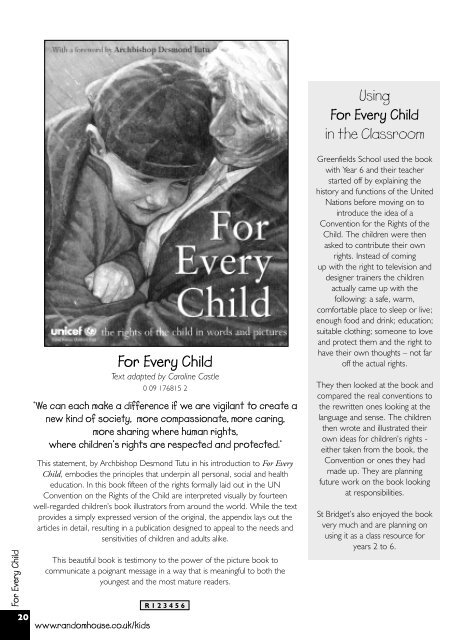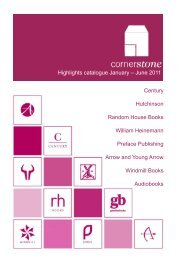Great Books for PSHE and Citizenship - Books at Random House
Great Books for PSHE and Citizenship - Books at Random House
Great Books for PSHE and Citizenship - Books at Random House
Create successful ePaper yourself
Turn your PDF publications into a flip-book with our unique Google optimized e-Paper software.
For Every Child<br />
For Every Child<br />
Text adapted by Caroline Castle<br />
0 09 176815 2<br />
‘We can each make a difference if we are vigilant to cre<strong>at</strong>e a<br />
new kind of society, more compassion<strong>at</strong>e, more caring,<br />
more sharing where human rights,<br />
where children’s rights are respected <strong>and</strong> protected.’<br />
This st<strong>at</strong>ement, by Archbishop Desmond Tutu in his introduction to For Every<br />
Child, embodies the principles th<strong>at</strong> underpin all personal, social <strong>and</strong> health<br />
educ<strong>at</strong>ion. In this book fifteen of the rights <strong>for</strong>mally laid out in the UN<br />
Convention on the Rights of the Child are interpreted visually by fourteen<br />
well-regarded children’s book illustr<strong>at</strong>ors from around the world. While the text<br />
provides a simply expressed version of the original, the appendix lays out the<br />
articles in detail, resulting in a public<strong>at</strong>ion designed to appeal to the needs <strong>and</strong><br />
sensitivities of children <strong>and</strong> adults alike.<br />
This beautiful book is testimony to the power of the picture book to<br />
communic<strong>at</strong>e a poignant message in a way th<strong>at</strong> is meaningful to both the<br />
youngest <strong>and</strong> the most m<strong>at</strong>ure readers.<br />
R 1 2 3 4 5 6<br />
20<br />
www.r<strong>and</strong>omhouse.co.uk/kids<br />
Using<br />
For Every Child<br />
in the Classroom<br />
Greenfields School used the book<br />
with Year 6 <strong>and</strong> their teacher<br />
started off by explaining the<br />
history <strong>and</strong> functions of the United<br />
N<strong>at</strong>ions be<strong>for</strong>e moving on to<br />
introduce the idea of a<br />
Convention <strong>for</strong> the Rights of the<br />
Child. The children were then<br />
asked to contribute their own<br />
rights. Instead of coming<br />
up with the right to television <strong>and</strong><br />
designer trainers the children<br />
actually came up with the<br />
following: a safe, warm,<br />
com<strong>for</strong>table place to sleep or live;<br />
enough food <strong>and</strong> drink; educ<strong>at</strong>ion;<br />
suitable clothing; someone to love<br />
<strong>and</strong> protect them <strong>and</strong> the right to<br />
have their own thoughts – not far<br />
off the actual rights.<br />
They then looked <strong>at</strong> the book <strong>and</strong><br />
compared the real conventions to<br />
the rewritten ones looking <strong>at</strong> the<br />
language <strong>and</strong> sense. The children<br />
then wrote <strong>and</strong> illustr<strong>at</strong>ed their<br />
own ideas <strong>for</strong> children’s rights -<br />
either taken from the book, the<br />
Convention or ones they had<br />
made up. They are planning<br />
future work on the book looking<br />
<strong>at</strong> responsibilities.<br />
St Bridget’s also enjoyed the book<br />
very much <strong>and</strong> are planning on<br />
using it as a class resource <strong>for</strong><br />
years 2 to 6.




